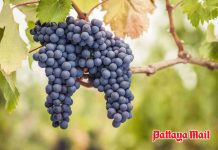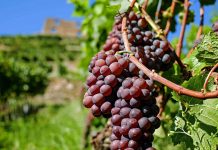It’s not often I get to taste Pinot Noir (PEE-noh NWAH) these days. Its spiritual home is the Burgundy region of France, where it’s used exclusively to make some of the best red wines anywhere. In recent years, red Burgundy has become terribly expensive and especially so in Thailand. Although the grape is very successful in New Zealand, some interesting Pinot Noirs are now coming out of South Africa.
It seems that Pinot Noir grapes are also popular with South African baboons, who invade the local vineyards in search of sweet treats. They prefer Pinot Noir to less expensive varieties and select only the ripest grapes. To the dismay of the wine growers, the baboons evidently enjoy Chardonnay grapes too and often become completely stoned after feasting on grapes that have fallen off the vines and have been fermenting in the sun.
These two wines wine come from Distell, a huge company with an extensive portfolio of trademarks. The name “Two Oceans” refers to the Indian Ocean and the Atlantic, which between them create cool breezes over the coast of South Africa, creating an ideal climate for ripening the grapes.
Justin Corrans makes the red wines for the “Two Oceans” brand and he and is extremely enthusiastic about the wine industry. “The vineyards are everything,” says Justin, “And good wine stems from good grapes. Because winemaking is extremely creative, it gives me the opportunity of being an inventive scientist in the cellar.”
Two Oceans Pinot Noir 2010 (red), South Africa (Villa Bt. 495)
Pour a glass of this bright ruby-red South African wine and a lovely aroma of strawberries wafts out of the glass to meet you. There are hints of cherries and a pleasant woody oakiness with dry herbs and spices lurking among the background aromas. There might even by a tiny dash of earthy vanilla in there too. There’s absolutely no smell of baboons, although to be honest I am not exactly sure what a baboon smells like.
 Winemaker Justin Corrans.
Winemaker Justin Corrans.
The strawberries are well up-front in this pleasant, medium-bodied wine and if you concentrate, you might pick up more hints of spice in the background. Actually, the taste is quite assertive and lively with a kind of sharp zesty bite on the palate. I noticed that after the bottle had been open for a while, it began to soften quite considerably. The tannins are very supple but they come through perfectly on the dry, smooth finish.
Justin Corrans has made a wine (at just under 13% alcohol content) that would make an excellent accompaniment to beef dishes or game. It would probably work well with pasta too: the clean mouth-feel of the wine would contrast well with a creamy sauce.
Two Oceans Sauvignon Blanc 2011 (white), South Africa (Villa Bt. 492)
Sauvignon Blanc (SOH-vee-nyon BLAHN) wines are often described as “zesty” because they retain a decent amount of acidity to keep them fresh. They’re often very aromatic with citrus flavours. The Sauvignon Blanc is a green-skinned grape variety which originates from the Bordeaux region. The name comes from the French word sauvage meaning “wild”.
This wine is a bright pale straw colour, with a greenish tinge. There’s a pronounced aroma of citrus and ripe gooseberries with a soft background smell of tropical fruit. Actually, the aroma is quite complex, which usually indicates a well-made wine. After the delicate introduction, the zingy fruitiness hits the palette with a pleasant surprise. The gooseberries are out in force in this lovely crisp wine and you might even pick up a hint of grassiness in the background. The light body is balanced by a splendid long creamy, lemony finish.
At just over 11.5% alcohol, this is a lively, well balanced young wine, full of joie de vivre. I’d be perfectly happy to drink this wine on its own but it would also make a jolly nice aperitif to perk up everyone’s appetite before dinner. You could serve it (very cold, of course) with food such as chicken, grilled fish or shellfish.
And while you’re drinking it, just feel grateful that those baboons didn’t get to the grapes first.




